Maximizing Corrosion Resistance of HA+Ce Coated Mg Implants Using Random Forest and Whale Optimization Algorithm
Abstract
1. Introduction
- Introducing a new HA-based coating through adding Ce to the solution containing HA nanoparticles (called HA+Ce), to improve its performance against corrosion. This is the first time that Ce has been added to HA-coated Mg implants.
- Presenting a combined machine learning–metaheuristic solution method based on RF and WOA to search for the best HA+Ce compound. To the best of our knowledge, this is the first study to utilize a hybrid technique based on machine learning and metaheuristic algorithms for coating optimization.
- Collecting a comprehensive dataset through generating and in vitro evaluating 1024 HA-Ce compounds with different coating factors (e.g., concentration, pH, immersion time, and temperature) using EIS and DC polarization tests.
- Training an RF model on the collected dataset and utilizing WOA to optimize the HA+Ce coating solution utilizing the RF model as the objective function. The WOA calls RF to estimate the corrosion resistance of new unseen coating solutions.
- Evaluating the corrosion resistance of the final optimized HA+Ce coating solution found by WOA-RF model using electrochemical impedance tests. Also, FE-SEM tests are used to investigate the quality of the surface of the final HA+Ce coating solution.
2. Literature Review
3. Experimental Design
3.1. Surface Preparation
3.2. Coatings Preparation
3.3. Anticorrosion Performance Evaluation
4. Optimization Methodology Using WOA-RF
| Algorithm 1. Combined WOA-RF model for optimizing the HA+Ce coating solution |
| Inputs: |
| Collected dataset comprising 1024 HA+Ce coating samples |
| Parameters of WOA (decision variables and ranges, population size, max iterations, and b) |
| Parameters of RF (No. DTs, aggregation rule, percentages of train and test data samples) |
| Data Collection: |
| 1. for s = 1: number of HA+Ce coating samples |
| 2. Generate the corresponding HA+Ce coating solution |
| 3. Evaluate the generated coating solution 4. Save the data sample: inputs (coating factors) and output (corrosion resistance) |
| 5. Save the input features and output resistance |
| 6. end for |
| 7. Dividing the whole dataset (1024 data samples) into train (70%) and test (30%) datasets |
| Training Phase: |
| 8. for t = 1 : number of DTs |
| 9. Train DT t using 50% of training samples (bagging method) |
| 10. end for 11. Save the trained RF model |
| Test Phase: |
| 12. for d = 1 : No. test samples |
| 13. for t = 1 : number of DTs |
| 14. Calculate the output of DT t for sample d |
| 15. end for |
| 16. Estimate the final output of sample d through aggregating the outputs of all DTs for sample d |
| 17. end for |
| 18. Generalizability evaluation of the RF model on test samples |
| Optimization Phase: |
| 19. Utilizing RF to estimate the corrosion resistance of HA+Ce coating solutions |
| 20. Applying WOA to find the best HA+Ce coating solution |
| Output: Optimized HA+Ce coating solution |
4.1. Data Collection
4.2. Machine Learning Model
4.3. Optimization Procedure Using WOA
4.3.1. Solution Representation
4.3.2. Objective Function Evaluation
4.3.3. Population Updating
- Search for prey: Each whale X may move toward other randomly selected whale, to emphasize more exploration. This action can be described as moving the whale in the direction of a randomly chosen whale Xtrand, as follows:
- Encircling prey: In each iteration, every whale has the ability to pinpoint the position of the prey, which represents the best solution found until that point (denoted as X*). The other whales then attempt to encircle this best solution by employing the encircling prey operator, as defined in Equation (7). Here, a represents a parameter that linearly decreases from 2 to 0, r is a randomly generated vector within the range of [0, 1], and t indicates the current iteration number.
- Bubble-net attacking: The movement pattern of whales, resembling a helix (known as bubble-net attacking behavior), can be represented using a spiral equation outlined in Equation (8). Here, l stands for a parameter chosen uniformly at random from the range of [−1, 1], while b is a constant typically set between 0 and 1.
5. Results and Discussion
5.1. Parameter Setting
5.2. Results of HA+Ce Coating
5.3. Results of RF
5.4. Results of WOA
5.5. Results of Optimized HA+Ce Coating Solution
6. Conclusions
Author Contributions
Funding
Data Availability Statement
Conflicts of Interest
References
- Jayasathyakawin, S.; Ravichandran, M.; Baskar, N.; Chairman, C.A.; Balasundaram, R. Mechanical properties and applications of Magnesium alloy—Review. Mater. Today Proc. 2020, 27, 909–913. [Google Scholar] [CrossRef]
- Ahangari, M.; Johar, M.H.; Saremi, M. Hydroxyapatite-carboxymethyl cellulose-graphene composite coating development on AZ31 magnesium alloy: Corrosion behavior and mechanical properties. Ceram. Int. 2021, 47, 3529–3539. [Google Scholar] [CrossRef]
- Li, Q.; Ye, W.; Gao, H.; Gao, L. Improving the corrosion resistance of ZEK100 magnesium alloy by combining high-pressure torsion technology with hydroxyapatite coating. Mater. Des. 2019, 181, 107933. [Google Scholar] [CrossRef]
- Ho, Y.H.; Man, K.; Joshi, S.S.; Pantawane, M.V.; Wu, T.C.; Yang, Y.; Dahotre, N.B. In-vitro biomineralization and biocompatibility of friction stir additively manufactured AZ31B magnesium alloy-hydroxyapatite composites. Bioact. Mater. 2020, 5, 891–901. [Google Scholar] [CrossRef]
- Zhu, Y.; Liu, W.; Ngai, T. Polymer coatings on magnesium-based implants for orthopedic applications. J. Polym. Sci. 2022, 60, 32–51. [Google Scholar] [CrossRef]
- Mohanasundaram, S.; Bhong, M.; Vatsa, G.; Verma, R.P.; Srivastava, M.; Kumar, G.; Gupta, L.R. Mg-based metal matrix composite in biomedical applications: A review. Mater. Today Proc. 2023. [Google Scholar] [CrossRef]
- Xing, F.; Li, S.; Yin, D.; Xie, J.; Rommens, P.M.; Xiang, Z.; Ritz, U. Recent progress in Mg-based alloys as a novel bioabsorbable biomaterials for orthopedic applications. J. Magnes. Alloys 2022, 10, 1428–1456. [Google Scholar] [CrossRef]
- Badkoobeh, F.; Mostaan, H.; Rafiei, M.; Bakhsheshi-Rad, H.R.; RamaKrishna, S.; Chen, X. Additive manufacturing of biodegradable magnesium-based materials: Design strategies, properties, and biomedical applications. J. Magnes. Alloys 2023, 11, 801–839. [Google Scholar] [CrossRef]
- Kumar, R.; Agrawal, A. Micro-hydroxyapatite reinforced Ti-based composite with tailored characteristics to minimize stress-shielding impact in bio-implant applications. J. Mech. Behav. Biomed. Mater. 2023, 142, 105852. [Google Scholar] [CrossRef]
- Yue, J.; Lou, G.; Zhou, G.; Leng, J.; Feng, Y.; Teng, X. Corrosion resistance of zinc phosphate conversion coatings on az91d surface. Mater. Sci. Forum 2020, 993, 1110–1117. [Google Scholar] [CrossRef]
- Cui, L.Y.; Cheng, S.C.; Liang, L.X.; Zhang, J.C.; Li, S.Q.; Wang, Z.L.; Zeng, R.C. In vitro corrosion resistance of layer-by-layer assembled polyacrylic acid multilayers induced Ca–P coating on magnesium alloy AZ31. Bioact. Mater. 2020, 5, 153–163. [Google Scholar] [CrossRef]
- Yadav, V.S.; Kumar, A.; Das, A.; Pamu, D.; Pandey, L.M.; Sankar, M.R. Degradation kinetics and surface properties of bioceramic hydroxyapatite coated AZ31 magnesium alloys for biomedical applications. Mater. Lett. 2020, 270, 127732. [Google Scholar] [CrossRef]
- Zhu, W.; Chen, F.; Yi, A.; Liao, Z.; Li, W.; Li, K.; Chen, K.; Liang, G.; Guo, J.T.; Wu, Q. Titanium, zirconium and vanadium conversion coatings (TZVCCs) on AZ91D magnesium alloy sheets. Mater. Res. Express 2020, 7, 86402. [Google Scholar] [CrossRef]
- Guo, Y.; Su, Y.; Gu, R.; Zhang, Z.; Li, G.; Lian, J.; Ren, L. Enhanced corrosion resistance and biocompatibility of biodegradable magnesium alloy modified by calcium phosphate/collagen coating. Surf. Coat. Technol. 2020, 401, 127322. [Google Scholar] [CrossRef]
- Rahimi, M.; Aghdam, R.M.; Sohi, M.H.; Rezayan, A.H.; Ettelaei, M. Improving biocompatibility and corrosion resistance of anodized AZ31 Mg alloy by electrospun chitosan/mineralized bone allograft (MBA) nanocoatings. Surf. Coat. Technol. 2021, 405, 126627. [Google Scholar] [CrossRef]
- Singh, N.; Batra, U.; Kumar, K.; Ahuja, N.; Mahapatro, A. Progress in bioactive surface coatings on biodegradable Mg alloys: A critical review towards clinical translation. Bioact. Mater. 2023, 19, 717–757. [Google Scholar] [CrossRef]
- Chen, J.; Liu, X.; Hong, Q.; Meng, L.; Ji, Y.; Wang, L.; Pan, C. Synthesizing a multifunctional polymer to construct the catalytically NO-generating coating for improving corrosion resistance and biocompatibility of the magnesium alloy stent materials. Prog. Org. Coat. 2024, 186, 108058. [Google Scholar] [CrossRef]
- Zomorodian, A.; Garcia, M.P.; Silva, T.M.E.; Fernandes, J.C.S.; Fernandes, M.H.; Montemor, M.F. Biofunctional composite coating architectures based on polycaprolactone and nanohydroxyapatite for controlled corrosion activity and enhanced biocompatibility of magnesium AZ31 alloy. Mater. Sci. Eng. C 2015, 48, 434–443. [Google Scholar] [CrossRef]
- Dorozhkin, S.V. Calcium orthophosphate coatings on magnesium and its biodegradable alloys. Acta Biomater. 2014, 10, 2919–2934. [Google Scholar] [CrossRef] [PubMed]
- Zhou, Z.; Zheng, B.; Gu, Y.; Shen, C.; Wen, J.; Meng, Z.; Chen, S.; Ou, J.; Qin, A. New approach for improving anticorrosion and biocompatibility of magnesium alloys via polydopamine intermediate layer-induced hydroxyapatite coating. Surf. Interfaces 2020, 19, 100501. [Google Scholar] [CrossRef]
- He, C.; Zhang, C.; Bian, T.; Jiao, K.; Su, W.; Wu, K.J.; Su, A. A Review on Artificial Intelligence Enabled Design, Synthesis, and Process Optimization of Chemical Products for Industry 4.0. Processes 2023, 11, 330. [Google Scholar] [CrossRef]
- Trinh, C.; Meimaroglou, D.; Hoppe, S. Machine learning in chemical product engineering: The state of the art and a guide for newcomers. Processes 2021, 9, 1456. [Google Scholar] [CrossRef]
- Petchimuthu, P.; Sumanth, G.B.; Kunjiappan, S.; Kannan, S.; Pandian, S.R.K.; Sundar, K. Green extraction and optimization of bioactive compounds from Solanum torvum Swartz. using ultrasound-aided solvent extraction method through RSM, ANFIS and machine learning algorithm. Sustain. Chem. Pharm. 2023, 36, 101323. [Google Scholar] [CrossRef]
- Yin, Y.; Jin, J.X.; Ren, G.P.; Wu, K.J.; He, C.H. Accelerated room temperature synthesis of desired cesium lead halide perovskite nanocrystals via automated microfluidic meta learner. Chem. Eng. Sci. 2023, 282, 119318. [Google Scholar] [CrossRef]
- Chen, X.; Shafizadeh, A.; Shahbeik, H.; Rafiee, S.; Golvirdizadeh, M.; Moradi, A.; Aghbashlo, M. Machine learning-based optimization of catalytic hydrodeoxygenation of biomass pyrolysis oil. J. Clean. Prod. 2024, 437, 140738. [Google Scholar] [CrossRef]
- Qikun, M.A. Machine learning-based optimization for catalytic sulfur removal: Computational modeling and analysis of fuel purification for reduction of environmental impacts. Case Stud. Therm. Eng. 2024, 53, 103835. [Google Scholar] [CrossRef]
- Jian, S.Y.; Yang, C.Y.; Chang, J.K. Robust corrosion resistance and self-healing characteristics of a novel Ce/Mn conversion coatings on EV31 magnesium alloys. Appl. Surf. Sci. 2020, 510, 145385. [Google Scholar] [CrossRef]
- Khast, F.; Saybani, M.; Dariani, A.A.S. Effects of copper and manganese cations on cerium-based conversion coating on galvanized steel: Corrosion resistance and microstructure characterizations. J. Rare Earths 2022, 40, 1002–1006. [Google Scholar] [CrossRef]
- Hsieh, C.Y.; Huang, S.Y.; Chu, Y.R.; Yen, H.W.; Lin, H.C.; Shih, D.S.; Kawamura, Y.; Lee, Y.L. Role of second phases in the corrosion resistance and cerium conversion coating treatment of as-extruded Mg–8Al–4Ca magnesium alloy. J. Mater. Res. Technol. 2023, 22, 2343–2359. [Google Scholar] [CrossRef]
- Mirjalili, S.; Lewis, A. The whale optimization algorithm. Adv. Eng. Softw. 2016, 95, 51–67. [Google Scholar] [CrossRef]
- Kazemi, S.; Ghamsarizade, R.; Yazdani, S.; Mohammadloo, H.E.; Yeganeh, H. The combined effect of hydroxyapatite and zirconia coatings on magnesium-based-implant to improve corrosion resistance and induce antibacterial activity. J. Alloys Compd. 2024, 971, 172790. [Google Scholar] [CrossRef]
- AhadiParsa, M.; Mohammadloo, H.E.; Mirabedini, S.M.; Roshan, S. Bio-corrosion assessment and surface study of hydroxyapatite-coated AZ31 Mg alloy pre-treated with vinyl tri-ethoxy silane. Mater. Chem. Phys. 2022, 287, 126147. [Google Scholar] [CrossRef]
- Lee, Y.L.; Chu, Y.R.; Chen, F.J.; Lin, C.S. Mechanism of the formation of stannate and cerium conversion coatings on AZ91D magnesium alloys. Appl. Surf. Sci. 2013, 276, 578–585. [Google Scholar] [CrossRef]
- Tang, M.; Xu, K.; Shang, H.; Li, X.; He, X.; Ke, L.; Xu, H. Biomineralization of bone-like hydroxyapatite to upgrade the mechanical and osteoblastic performances of poly (lactic acid) scaffolds. Int. J. Biol. Macromol. 2023, 226, 1273–1283. [Google Scholar] [CrossRef]
- Afshari, M.; Mohammadloo, H.E.; Sarabi, A.A.; Roshan, S. Modification of hydroxyapatite-based coating in the presence of polyvinylalcohol (PVA) for implant application: Corrosion. Corros. Sci. 2021, 192, 109859. [Google Scholar] [CrossRef]
- Esmaeili, H.; Hakami, V.; Bidgoli, B.M.; Shokouhifar, M. Application-specific clustering in wireless sensor networks using combined fuzzy firefly algorithm and random forest. Expert Syst. Appl. 2022, 210, 118365. [Google Scholar] [CrossRef]
- Ozcan, M.; Peker, S. A classification and regression tree algorithm for heart disease modeling and prediction. Healthc. Anal. 2023, 3, 100130. [Google Scholar] [CrossRef]
- Breiman, L.; Friedman, J. Classification and Regression Trees, 1st ed.; Routledge: London, UK, 2017. [Google Scholar] [CrossRef]
- Kumar, A.; Sinha, S.; Saurav, S. Random forest, CART, and MLR-based predictive model for unconfined compressive strength of cement reinforced clayey soil: A comparative analysis. Asian J. Civ. Eng. 2024, 25, 2307–2323. [Google Scholar] [CrossRef]
- Bhagat, N.K.; Mishra, A.K.; Singh, R.K.; Sawmliana, C.; Singh, P.K. Application of logistic regression, CART and random forest techniques in prediction of blast-induced slope failure during reconstruction of railway rock-cut slopes. Eng. Fail. Anal. 2022, 137, 106230. [Google Scholar] [CrossRef]
- Breiman, L. Random forests. Mach. Learn. 2001, 45, 5–32. [Google Scholar] [CrossRef]
- Handa, K.; Wright, P.; Yoshimura, S.; Kageyama, M.; Iijima, T.; Bender, A. Prediction of Compound Plasma Concentration–Time Profiles in Mice Using Random Forest. Mol. Pharm. 2023, 20, 3060–3072. [Google Scholar] [CrossRef] [PubMed]
- Asadi, B.; Hajj, R. Prediction of asphalt binder elastic recovery using tree-based ensemble bagging and boosting models. Constr. Build. Mater. 2024, 410, 134154. [Google Scholar] [CrossRef]
- Aryai, P.; Khademzadeh, A.; Jassbi, S.J.; Hosseinzadeh, M.; Hashemzadeh, O.; Shokouhifar, M. Real-time health monitoring in WBANs using hybrid Metaheuristic-Driven Machine Learning Routing Protocol (MDML-RP). Int. J. Electron. Commun. 2023, 168, 154723. [Google Scholar] [CrossRef]
- Xu, Z.; Su, Y.; Yang, F.; Zhang, M. A Whale Optimization Algorithm with Distributed Collaboration and Reverse Learning Ability. Comput. Mater. Contin. 2023, 75, 5965–5986. [Google Scholar] [CrossRef]
- Ali, M.U.; Kim, K.S.; Kallu, K.D.; Zafar, A.; Lee, S.W. OptEF-BCI: An Optimization-Based Hybrid EEG and fNIRS–Brain Computer Interface. Bioengineering 2023, 10, 608. [Google Scholar] [CrossRef]
- Shokouhifar, M. FH-ACO: Fuzzy heuristic-based ant colony optimization for joint virtual network function placement and routing. Appl. Soft Comput. 2021, 107, 107401. [Google Scholar] [CrossRef]
- Zhao, W.; Wang, L.; Mirjalili, S. Artificial hummingbird algorithm: A new bio-inspired optimizer with its engineering applications. Comput. Methods Appl. Mech. Eng. 2022, 388, 114194. [Google Scholar] [CrossRef]
- Azizi, M.; Talatahari, S.; Gandomi, A.H. Fire Hawk Optimizer: A novel metaheuristic algorithm. Artif. Intell. Rev. 2023, 56, 1–77. [Google Scholar] [CrossRef]
- Abdollahzadeh, B.; Khodadadi, N.; Barshandeh, S.; Trojovský, P.; Gharehchopogh, F.S.; El-kenawy, E.S.M.; Mirjalili, S. Puma optimizer (PO): A novel metaheuristic optimization algorithm and its application in machine learning. Clust. Comput. 2024, 1–49. [Google Scholar] [CrossRef]


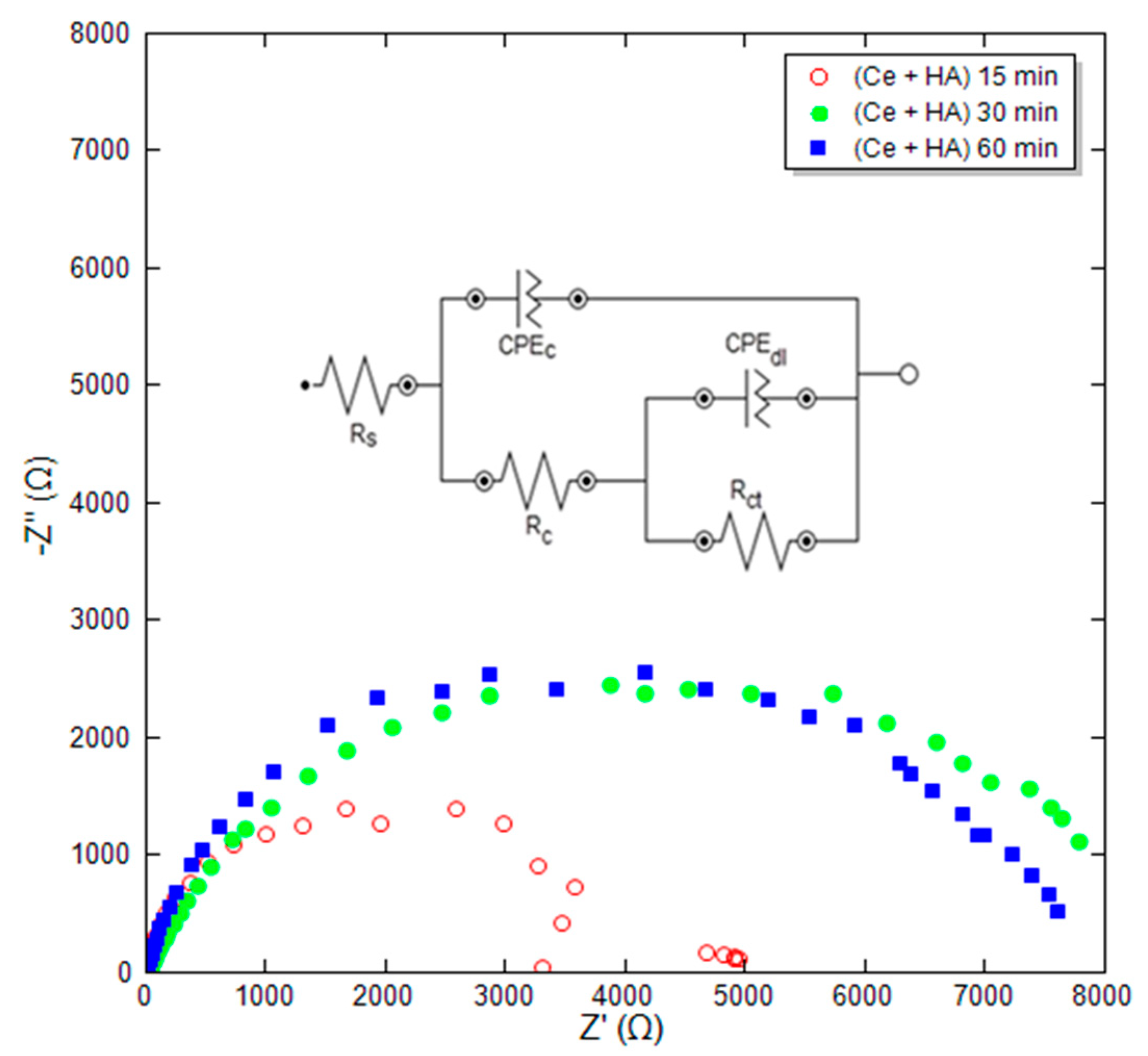
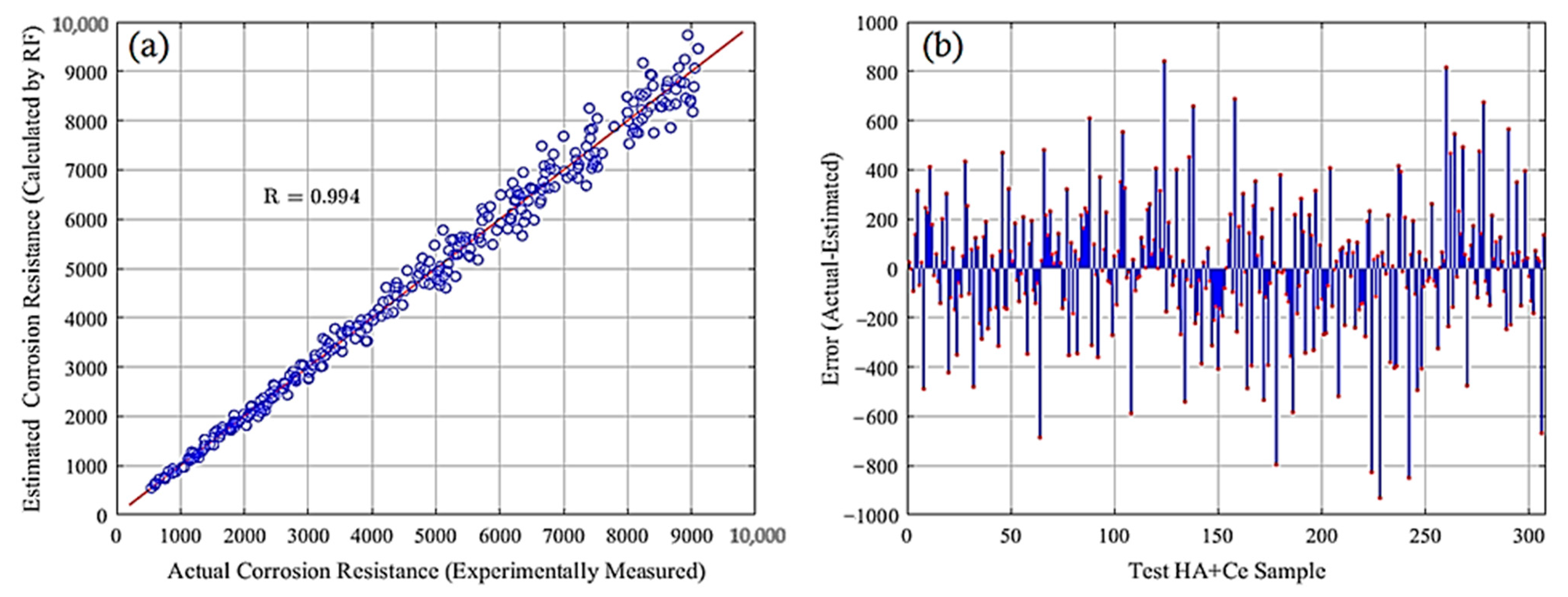
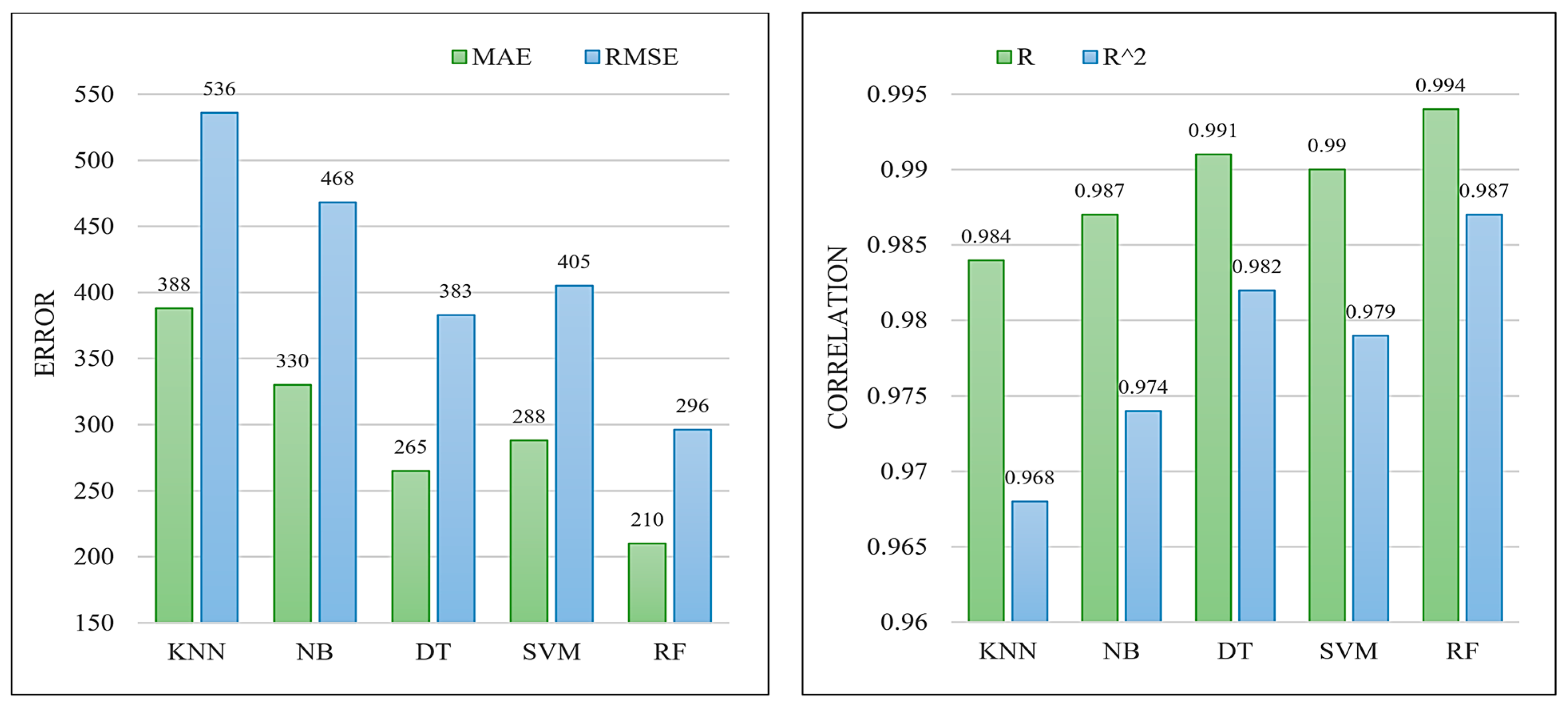
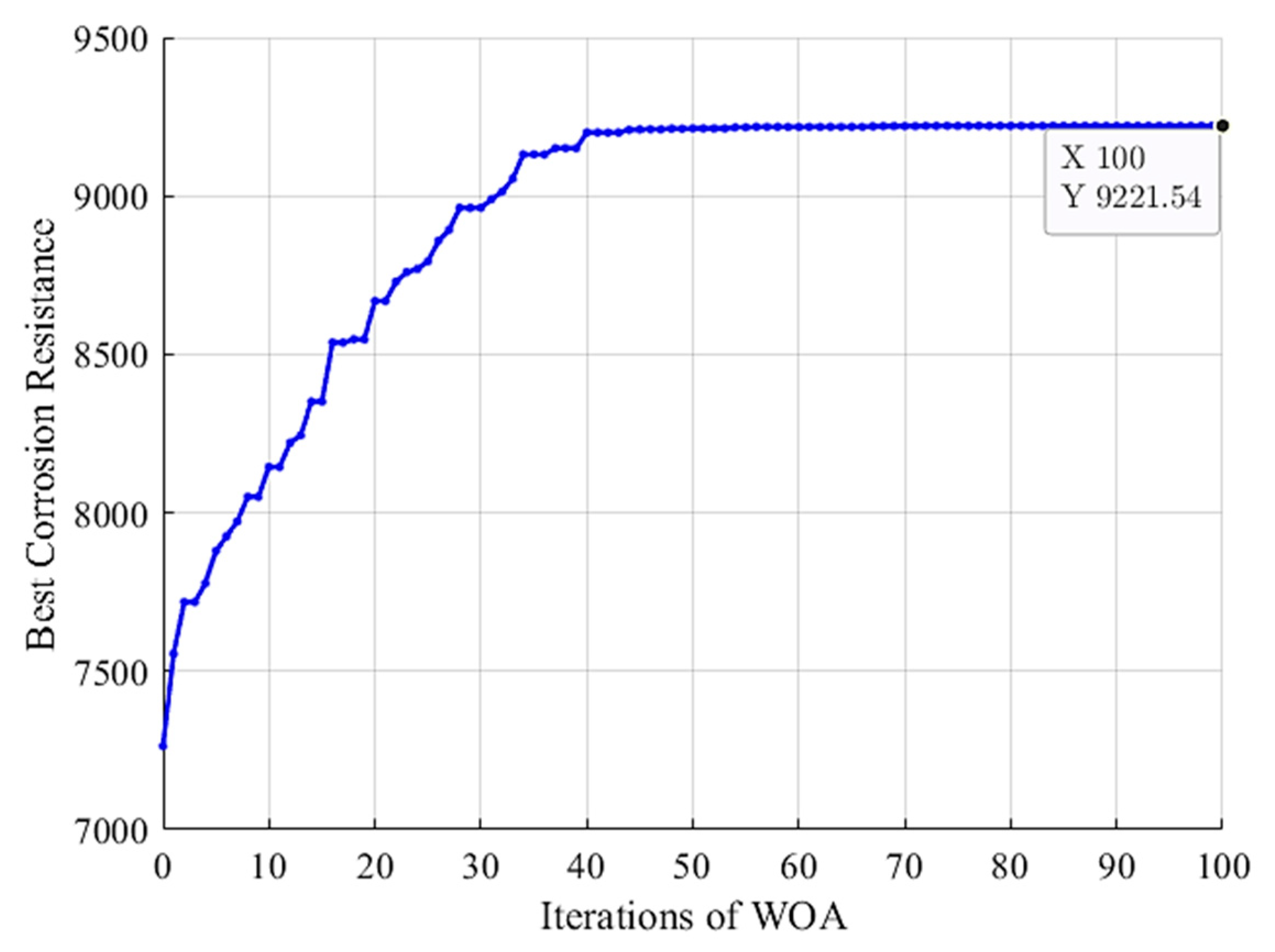

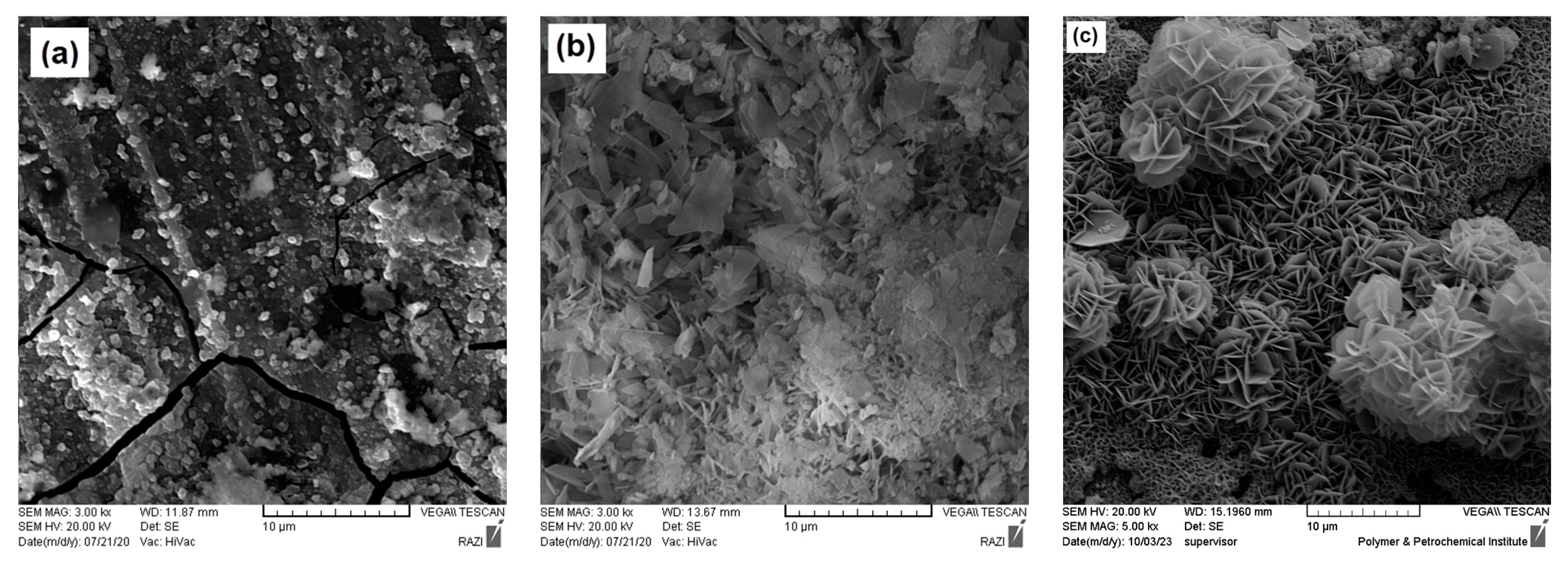
| S. No. | Reagents | Amount in 1000 mL |
|---|---|---|
| 1 | NaCl | 8.035 g |
| 2 | (HOCH2)3CNH2 | 6.118 g |
| 3 | NaHCO3 | 0.355 g |
| 4 | MgCl2·6H2O | 0.311 g |
| 5 | CaCl2 | 0.292 g |
| 6 | KCl | 0.225 g |
| 7 | K2HPO4·3H2O | 0.231 g |
| 8 | Na2SO4 | 0.072 g |
| 9 | 1.0 M HCl | 39.0 mL |
| 10 | 1.0 M HCl | pH ~ 7.4 |
| Sample | Parameter | Range |
|---|---|---|
| Ce Coating | Ce pH | 2–6 |
| Ce Concentration (mol/L) | 0.01–2 | |
| Ce Temperature (Celsius) | 5–50 | |
| Ce Immersion time (seconds) | 5–180 | |
| HA Coating | HA pH | 2–6 |
| HA Concentration (gr/L) | 0.1–10 | |
| HA Temperature (Celsius) | 50–90 | |
| HA Immersion time (minutes) | 5–120 | |
| HA+Ce Coating | HA+Ce pH | 2–6 |
| HA+Ce Temperature (Celsius) | 50–90 | |
| HA+Ce Immersion time (minutes) | 5–120 | |
| Ce Concentration (mol/L) | 0.01–2 | |
| HA Concentration (gr/L) | 0.1–10 |
| Phase | Parameter | Definition | Value |
|---|---|---|---|
| RF | D | Number of collected HA+Ce data samples | 1024 |
| DTrain | Number of train data samples | 717 (70%) | |
| DTest | Number of test data samples | 307 (30%) | |
| T | Number of DTs within RF model | 10 | |
| WOA | PopSize | Population of WOA | 50 |
| MaxIter | Iterations of WOA | 100 | |
| NumVar | Number of decision variables | 9 |
| Sample | RS (Ω·cm2) | Rc (Ω·cm2) | Rct (Ω·cm2) | Rp (Ω·cm2) | n1 | Y0 (1) (sn/Ω/cm2) | n2 | Y0 (2) (sn/Ω/cm2) |
|---|---|---|---|---|---|---|---|---|
| Ce+HA 15 min | 18.5 | 1498 | 3522 | 5020 | 0.78 | 8.05 | 0.83 | 11.43 |
| Ce+HA 30 min | 25.77 | 3472 | 5680 | 9152 | 0.89 | 12.77 | 0.81 | 4.72 |
| Ce+HA 60 min | 26.12 | 3145 | 4665 | 7810 | 0.9 | 15.2 | 0.85 | 7.86 |
| Metric | Training Samples | Test Samples |
|---|---|---|
| MAE | 221.7 | 210.9 |
| RMSE | 308.5 | 296.1 |
| MPE (%) | 4.3 | 4.2 |
| R | 0.994 | 0.994 |
| R2 | 0.986 | 0.987 |
| Metric | KNN | NB | DT | SVM | RF |
|---|---|---|---|---|---|
| MAE | 388.2 | 330.3 | 265.7 | 288.6 | 210.9 |
| RMSE | 536.1 | 468.0 | 383.4 | 405.5 | 296.1 |
| MPE (%) | 7.9 | 7.0 | 5.6 | 6.1 | 4.2 |
| R | 0.984 | 0.987 | 0.991 | 0.990 | 0.994 |
| R2 | 0.968 | 0.974 | 0.982 | 0.979 | 0.987 |
| Parameter | Optimized Value |
|---|---|
| Ce Concentration (mol/L) | 0.9 |
| HA Concentration (gr/L) | 1.2 |
| Ce pH | 4.7 |
| HA pH | 4.1 |
| Ce Temperature (Celsius) | 35 |
| HA Temperature (Celsius) | 70 |
| Ce Immersion time (seconds) | 50 |
| HA Immersion time (minutes) | 75 |
| HA+Ce Immersion time (minutes) | 60 |
| Immersion Time | Bare Mg | HA | HA+Ce |
|---|---|---|---|
| 1 h | 370 | 12,229 | 14,050 |
| 1 day | 506 | 4265 | 12,620 |
| 1 week | 727 | 4100 | 9432 |
| 2 weeks | 510 | 3215 | 7830 |
| 3 weeks | 312 | 2537 | 5190 |
Disclaimer/Publisher’s Note: The statements, opinions and data contained in all publications are solely those of the individual author(s) and contributor(s) and not of MDPI and/or the editor(s). MDPI and/or the editor(s) disclaim responsibility for any injury to people or property resulting from any ideas, methods, instructions or products referred to in the content. |
© 2024 by the authors. Licensee MDPI, Basel, Switzerland. This article is an open access article distributed under the terms and conditions of the Creative Commons Attribution (CC BY) license (https://creativecommons.org/licenses/by/4.0/).
Share and Cite
Rajabi, Z.; Afshar Taromi, F.; Pourmahdian, S.; Eivaz Mohammadloo, H. Maximizing Corrosion Resistance of HA+Ce Coated Mg Implants Using Random Forest and Whale Optimization Algorithm. Processes 2024, 12, 490. https://doi.org/10.3390/pr12030490
Rajabi Z, Afshar Taromi F, Pourmahdian S, Eivaz Mohammadloo H. Maximizing Corrosion Resistance of HA+Ce Coated Mg Implants Using Random Forest and Whale Optimization Algorithm. Processes. 2024; 12(3):490. https://doi.org/10.3390/pr12030490
Chicago/Turabian StyleRajabi, Zeinab, Faramarz Afshar Taromi, Saeed Pourmahdian, and Hossein Eivaz Mohammadloo. 2024. "Maximizing Corrosion Resistance of HA+Ce Coated Mg Implants Using Random Forest and Whale Optimization Algorithm" Processes 12, no. 3: 490. https://doi.org/10.3390/pr12030490
APA StyleRajabi, Z., Afshar Taromi, F., Pourmahdian, S., & Eivaz Mohammadloo, H. (2024). Maximizing Corrosion Resistance of HA+Ce Coated Mg Implants Using Random Forest and Whale Optimization Algorithm. Processes, 12(3), 490. https://doi.org/10.3390/pr12030490









